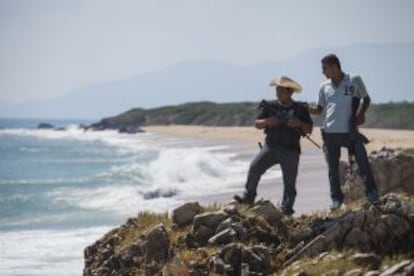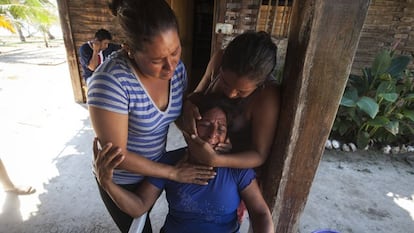Death of child in Michoacán throws state security efforts into question
Mexico demands answer from government after tragic shooting death of 12-year-old

Sitting on a plastic chair, under the shade of a large canopy made from branches, Emilia García Cabrera sobs for her son.
A crucifix made from candles is sat in the middle of the concrete floor. Among those in the small gathering of people who are comforting García is a group of armed men, wearing black shirts that read: “Community Police.”
Once again Mexico is demanding answers from the government after another tragic shooting death under mysterious circumstances took place earlier this month in troubled Michoacán state, where armed citizen vigilantes have been fighting drug traffickers for more than two years.
In Michoacán state, armed citizen vigilantes have been fighting drug traffickers for more than two years
Hidelberto Reyes García, aged just 12, was shot dead as he tried to escape bullets coming from a shootout that took place on July 19 between vigilantes and their supporters, and the Mexican army and state and federal police forces, according to witnesses.
Armed with sticks and rifles, local residents had tried to block a road in the Pacific resort of Ixtapilla in Aquila municipality to protest the arrest of Cemeí Verdía, the head of the rural police in the local indigenous Nahua community.
The people of Ixtapilla blame the military for the shooting death. But at a press conference, General Felipe Gurrola, who is in charge of security in Michoacán, denied the allegation and explained that soldiers fired their weapons in the air to disperse the crowd.
“They didn’t fire in the air. I wasn’t flying when I was hit,” says 17-year-old Delfino Antonio Alejo, who was wounded by a bullet in his right buttock.
Alejo recalls how he saw soldiers fire their weapons at the protestors.
“There’s no doubt it was the army,” he says. “You could see that it read Mexican Army on their bullet-proof vests.”
The high-profile shooting incident is the latest of its kind to have put the Mexican government in a bind. Human rights groups and other organizations have blamed the army for massacring a group of innocent people officials alleged were drug traffickers in Tlatlaya last year.
In September, 43 teaching students were kidnapped and apparently later killed in Iguala, Guerrero state, in what government investigators have ruled a massacre carried out by hitmen on the orders of local drug traffickers.
The families of the students, however, blame the Mexican army for the deaths after reports surfaced that a group of soldiers had run into them before the tragedy took place.

In this latest incident, Alejo admits that he took part in the demonstration after taking some bean tacos to his father. But when the situation began getting out of control, he says he left.
The first convoy of security vehicles didn’t fire at the crowds. “It was the seventh or eighth vehicle that began firing,” he says, explaining that he began feeling a stinging sensation in his leg while he ran toward the beach. A tourist from the United States, who was trapped in the small town because of the blockade, took him to a hospital in nearby Colima state.
At least two helicopters and 500 members of Mexico’s security forces helped in the capture of 35-year-old Verdía, who was charged with possessing weapons that belonged to the army.
His arrest is another in a series of revelations of the Mexican government’s failure to disarm private citizens in violent Michoacán, the state with the fourth-highest murder rate in the country.
Members of the rural police force say they will maintain the roadblock until their leader is released
Vigilante groups began to organize in early 2013 after the drug trafficking cartels Los Caballeros Templarios (Knights Templar) and La Familia Michoacana started terrorizing local residents.
In January 2014, Mexican President Enrique Peña Nieto sent in federal troops to help pacify the state but the violence still continues.
Cemeí was one of the local leaders who took up arms to fight the cartels.
“The government even gave him a vehicle. We have documents with proof that they gave him weapons and made him a police officer,” says his lawyer Ignacio Mendoza. “They cannot come over here and say that he was acting like a wildcat.”
Meanwhile, more than 160 members of the rural police force say they will maintain the roadblock until their leader is released.
The incident comes two months ahead of Michoacán’s new governor Silvano Aureoles takes office. Just before his June 7 election victory, the Institutional Revolutionary Party (PRI) official said that he would not permit any self-defense forces to remain after he is sworn in.
Even though many support the vigilante groups, others question their abilities.
“Things haven’t been done right,” says one store owner in Aquila. “They have given weapons to people who are not properly trained. Even though the soldiers and the navy are capable and psychologically trained, they still commit abuses. So you can imagine what is done by those who don’t have any type of training.”
Tu suscripción se está usando en otro dispositivo
¿Quieres añadir otro usuario a tu suscripción?
Si continúas leyendo en este dispositivo, no se podrá leer en el otro.
FlechaTu suscripción se está usando en otro dispositivo y solo puedes acceder a EL PAÍS desde un dispositivo a la vez.
Si quieres compartir tu cuenta, cambia tu suscripción a la modalidad Premium, así podrás añadir otro usuario. Cada uno accederá con su propia cuenta de email, lo que os permitirá personalizar vuestra experiencia en EL PAÍS.
¿Tienes una suscripción de empresa? Accede aquí para contratar más cuentas.
En el caso de no saber quién está usando tu cuenta, te recomendamos cambiar tu contraseña aquí.
Si decides continuar compartiendo tu cuenta, este mensaje se mostrará en tu dispositivo y en el de la otra persona que está usando tu cuenta de forma indefinida, afectando a tu experiencia de lectura. Puedes consultar aquí los términos y condiciones de la suscripción digital.
Últimas noticias
Tiger Woods turns 50: Will he continue playing on the PGA Tour or take a back seat?
The surreal journey of James Nnaji, the Barcelona youth player selected in the NBA Draft who ended up in the NCAA
Trump claims peace in Ukraine is near, but Moscow suggests otherwise
A survivor’s account of the Interoceanic Train accident: ‘We were scared because of the speed on the curve’
Most viewed
- Oona Chaplin: ‘I told James Cameron that I was living in a treehouse and starting a permaculture project with a friend’
- Reinhard Genzel, Nobel laureate in physics: ‘One-minute videos will never give you the truth’
- Why the price of coffee has skyrocketed: from Brazilian plantations to specialty coffee houses
- Pablo Escobar’s hippos: A serious environmental problem, 40 years on
- Chevy Chase, the beloved comedian who was a monster off camera: ‘Not everyone hated him, just the people who’ve worked with him’









































